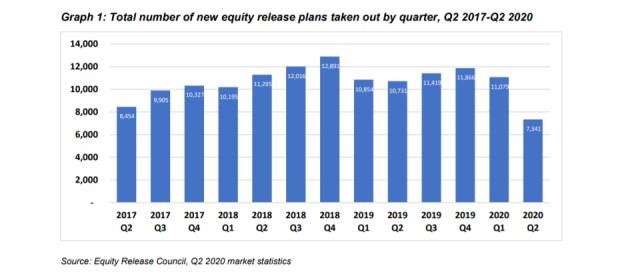
Article 1 / 4
How equity release has evolvedWhat has changed in the equity release market?

Additionally, with pension saving not keeping up with life expectancy and significant numbers of people finding that their home - which has risen in value over the past 20 years - is their largest asset, more people are considering how they can use their housing equity to support their needs and wants in retirement.
So how have equity release products become more flexible in recent years and what is driving the increased competition among lenders?
Will Hale, chief executive at Key, says over the past decade, lenders have responded to the changing needs of customers and advisers and delivered significant product innovations.
Currently, there are more than 400 products on the market as opposed to 144 just two years ago, adding flexibility for those considering equity release.
Historically, interest on equity release plans would roll up and be added to the balance to be repaid when the house was sold by the customer or their estate, or when the customer moved into long-term care.
Now, customers can choose to make monthly repayments, no repayments at all, or make flexible payments.
Mr Hale adds: “An ever more diverse range of customers are exploring late-life lending options,but as a sector we are better able to put solutions in place to meet individual needs and circumstances than ever before.”

It’s fair to say that the equity release market continues to evolve and adapt to changing customer needs, but this also brings an element of complexity around product selection for advisers.
Interestingly, the available product options now exceed 300, a 42 per cent increase in the last year as reported by the Equity Release Council in their April 2020 report. In recent years,
Georgina Oxton, strategic sales manager at LV, says the lender has seen changing trends in the way customers are leveraging their property to supplement their retirement income.
Ms Oxton adds: "Today’s equity release customer is a lot more focused on planning for the future and having control over their finances. Naturally, this means flexible product options are the preferred route.
"Customers would like to have the option to control interest roll-up if they choose to and flexibility varies widely from lender to lender. When designing our new Lifetime Mortgage Drawdown+ product we reviewed the market context.
"We understand that customer circumstances can change and we therefore prefer to offer flexibility so they can vary both the amount and frequency of any interest repayments."
Changing customer attitudes
Paula Steele, director at John Lamb Hill Oldridge, believes the popularity of equity release has also grown because clients are more open to equity release as one strategy they can use to meet their objectives.
She says: “They feel it is a valid option which it wasn’t previously. Low interest rates help, and also the growth in property prices has been so large that some think they can spend some of it.
Market growth has led to increased customer segmentation, as Steve Wilkie, chairman at Responsible Life, explains.
Equity release customers have a variety of needs that can be placed into three categories:
- Refinancing: either existing mortgages or unsecured debt.
- Future planning: advancing an inheritance early to family or planning their estate.
- Aspirational: looking to supplement their finances with their housing wealth to enjoy their life more.
Advisers also have products available which offer features such as inheritance protection.
Additionally, there are a variety of different redemption bases of calculating penalties; in many cases early repayment waivers on death and on going into care.
Most products will allow the customer to repay 10 per cent of the loan each year without penalty, with one lender allowing as much as 40 per cent of the loan to be repaid each year without any charges.
Mr Wilkie says: “Equity release products have responded to some of the past criticisms about inflexibility and now have a range of features that allow a customer to choose how they are used and how they will run throughout the term.”
Market competition
According to Claire Singleton, chief executive of Legal and General Home Finance, these developments have been driven by the competitiveness of the market as well as its maturity.
Ms Singleton adds: “Good providers have listened to customers over the years and designed products to suit their needs.
“As awareness and demand for equity release has increased, the market has adapted, with greater flexibility and more choice allowing people to unlock the wealth tied up in their home.
“We think even product innovations around ‘green’ concerns could become more prevalent in the future.”
However, the increased popularity of the market has meant more complexity, particularly around advice, as evidenced in the recent FCA review into equity release and advice.
Although the regulator acknowledged the benefits of equity release products, it found examples of poor outcomes:
- Younger consumers not being told of their other borrowing options, such as traditional mortgages.
- Short-term benefits, such as consolidating debts and freeing up cash, being wiped out by the long-term cost of equity release, as the interest rolls-up (rather than being paid monthly) and compounds over many years.
- Customers paying substantial early repayment charges of tens of thousands of pounds only a few years after taking their loan, because their circumstances have changed.
- Consumers limiting their ability to release further cash or downsize in the future without repaying their equity release in full.
The FCA also found three significant areas of concern around the suitability of advice provided, which increases the risk of harm to consumers in this market:
- Insufficient personalisation of advice.
- Insufficient challenging of customer assumptions.
- Lack of evidence to support the suitability of advice.
Mr Hale says: “Advice meetings need to be highly personal, to explore in detail individual circumstances and be supported by documentation that works from a customer communication perspective – not as just a way of ticking the compliance box.
“That said, it is good that the FCA acknowledged that in their review they had seen some good outcomes where consumers ended up with an equity release product that met their long-term needs.
Ms Steele adds: “Advice is not personal enough and in many cases leaves a lot to be desired. I think this is slightly a function of the average release being less than £50,000 and it’s difficult to give personal advice at that level.
“Hopefully as advisers upskill the standards of advice will get better.”
The Equity Release Council says it has taken the call for improvement “very seriously” and has renewed its rules and guidance to ensure they are robust.
These include the recently updated Checklist for Advisers which highlights some of the most significant factors to consider during the advice process.
It prompts advisers to recommend that customers review or set up a will and seek advice from a solicitor or qualified person if they do not have a Power of Attorney.
It also underlines the importance of establishing if a customer has experienced difficulties with their physical or mental health, bereavement, divorce, emotional or financial issues, literacy, numeracy, or any other traumatic event, that may leave them in a vulnerable position.
Where a customer is re-mortgaging onto a lower interest rate or to release further capital, the checklist captures the need for a detailed analysis of features and benefits to compare the existing and recommended new plan.
Jim Boyd, chief executive at Equity Release Council, adds: “We are also continuing to work on new initiatives and resources to support consistent advice across the market, as more firms respond to growing interest from consumers.”
ima.jacksonobot@ft.com





